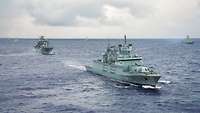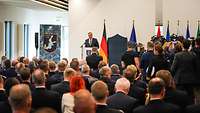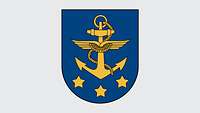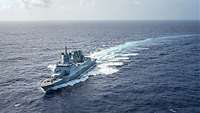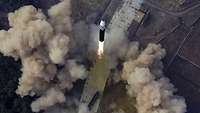The Navy - a Multitool in Ever Greater Demand
The Navy - a Multitool in Ever Greater Demand
- Date:
- Place:
- Rostock
- Reading time:
- 6 MIN
Open and secure sea routes both worldwide and in home waters were the Navy’s guiding principle in 2024. The German naval forces are looking back on an intensive twelve months. Strengthening defence capabilities while simultaneously supporting international crisis management is a major challenge.
Free maritime traffic is not only the basis of prosperity for the trading nation of Germany but is of fundamental strategic interest for all countries worldwide. The struggle for the right political system as well as for power and influence leads to growing geopolitical tensions, which also affect maritime security and cause instability in several sea areas. A guiding principle of the Navy's commitment in the different regions of the world is therefore to support the rules-based international order and multinational cooperation. This approach offers maritime trade routes the best protection.
However, the attacks by Yemeni Houthi rebels on shipping traffic in the Red Sea begun in late 2023 are only the latest event showing that even crisis management operations may require naval forces to employ a range of capabilities that they would also need in a major conflict between nation states.
Maritime terrorists conduct high-intensity naval warfare
In fact, the military weapons of the Houthis come from the arsenals of their supporter states. Unlike pirates, they no longer only use assault rifles and RPGs but ballistic and guided anti-ship missiles as well as unmanned aerial, surface and underwater vehicles. In addition, potentially disruptive technologies, which are shaping today’s battlefields and very probably will also shape tomorrow’s, will play a part in possible crises and conflicts worldwide.
In practical terms, for the German Navy this means the following: At any time, the Navy must be able to prevail in complex multi-dimensional operations up to and including intensive maritime combat. This is a prerequisite for the Navy to be prepared for all types of crisis management operations. In view of the current threats, in particular those posed by Russia, NATONorth Atlantic Treaty Organization expects its members to step up their engagement at the same time.
A look at the current missions of the Navy reveals some of the maritime threats worldwide:
• deployment as part of two of the four Standing NATONorth Atlantic Treaty Organization Maritime Groups in the North Sea and the Baltic Sea,
• NATONorth Atlantic Treaty Organization’s counter-terrorism Operation Sea Guardian conducted in the entire Mediterranean Sea,
• the EUNAVFOREuropean Union Naval Forces ASPIDES operation conducted to protect sea routes in the Red Sea,
• the UNIFILUnited Nations Interim Force in Lebanon arms embargo operation conducted off the coast of and in Lebanon itself,
• the EUNAVFOREuropean Union Naval Forces IRINI arms embargo operation conducted in the central Mediterranean Sea, and
• NATONorth Atlantic Treaty Organization's deployment designed to prevent human smuggling in the Aegean Sea.
Furthermore, the German Navy continues to be involved in the training of Ukrainian armed forces.
In addition to the threats related to these current operations, there are maritime threats caused by the impact of the Ukraine War in the Black Sea and growing tensions in the Indo-Pacific. These and other conflict hotspots around the world are increasingly influencing and reinforcing each other. The “no-limits friendship” between China and Russia that both countries have declared is just as much a part of this setting as is the military support provided to Russia by Iran and North Korea.
The German Fleet shows presence in its commitment to international law
Just like in 2021, the Navy meanwhile once again demonstrated presence for secure and free sealines of communication with its Indo-Pacific Deployment (IPDIndo-Pacific Deployment) in 2024. From May to December, a formation of two German naval vessels sailed around the globe in an endeavour that also included transit through international waters between mainland China and the island of Taiwan.
The IPDIndo-Pacific Deployment 2024 was also a major project of German maritime defence diplomacy. The frigate “Baden-Württemberg” and the combat support ship “Frankfurt am Main” visited ports of strategic partners and participated in many naval exercises together with one or more partners. Not least, the Navy took part in operations such as the monitoring of UNUnited Nations sanctions against North Korea.
Back at home, the establishment of the maritime Commander Task Force Baltic (CTFCommander Task Force Baltic) in October 2024 was a milestone that saw the German Navy assume a leading role for its NATONorth Atlantic Treaty Organization partners in the Baltic Sea. The reason for this is that, with regard to Euro-Atlantic security, it is particularly the Baltic Sea but also the North Sea, the Atlantic Ocean and the Arctic Ocean that have increasingly become the focus of German defence planning once again.
More responsibility for Germany on NATONorth Atlantic Treaty Organization's Northern and Eastern Flank
This is because the Navy's commitment to the freedom of navigation also includes the defence of sea lines of communication in national and Allied waters. The Russian war of aggression against Ukraine with the temporary blockade of Ukrainian grain exports has reminded us that wars between states have diverse consequences for maritime trade, the supply of the population, and military resupply.
This means that the tasks of the new regional CTFCommander Task Force Baltic Headquarters now are to plan joint naval exercises and operations of the NATONorth Atlantic Treaty Organization partners of the Baltic region – as part of the Alliance's deterrence efforts – and to compile a common maritime situation picture.
The latter objective also includes analysing civilian shipping traffic in this sea area, especially with a view to possible threats. Such threats are posed not only by warships but also by the manipulation of GPSGlobal Positioning System navigation, by the Russian shadow fleet trying to circumvent sanctions and thus endangering both traffic and the environment, or by Russian and Chinese research vessels mapping maritime infrastructure. Especially in the Baltic Sea, close cooperation with our partners is of essential importance since it is one of the waters with the highest traffic density in the world.
A comprehensive situation picture in the continuum of peace, crisis and conflict in combination with the broadest naval presence possible is also intended to deter acts of sabotage on maritime critical infrastructure – for ports, underwater infrastructure, shipping routes and offshore installations are indispensable for the flow of energy and goods and thus for the German economy.
Simultaneous crises are calling for quick and decisive action
For the German Navy, the year 2024 has mainly made one thing clear: the simultaneity of all tasks to be accomplished presents enormous challenges to the naval forces. Already today, addressing these challenges or even just being able to address them is placing great demands on the operational readiness of German naval service members and that of the vessels, aircraft and helicopters available. Going forward, fulfilling these demands will stretch the Navy to the limit in terms of both personnel and materiel.
In the foreseeable future, this will warrant further investments for the ongoing threat-adapted modernisation of the existing fleet and for the generation change with new systems. Our flagship projects are the 212CD submarines developed together with Norway, unmanned maritime surveillance systems, and the Type 127 air defence frigates.
All of this requires tremendous effort. Like the Bundeswehr as a whole, the Navy needs broad political and social support. That will be crucial particularly in the years to come – years in which Russia as a potential adversary will gain the capability to attack NATONorth Atlantic Treaty Organization. Strong German armed forces, including a strong fleet, must deter Russia from doing so.
This is all the more true in light of demands from the United States – Germany’s most important ally also and especially after the presidential elections – and from the European partners, who both want Germany to become a central pillar of European security in accordance with its political and economic importance. In this regard, protection of the sea routes will remain a guiding principle in the future.


